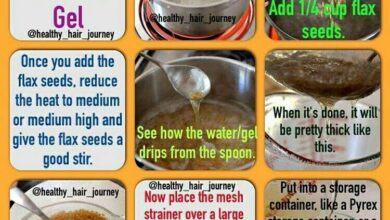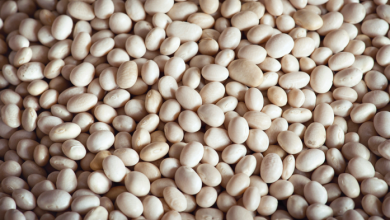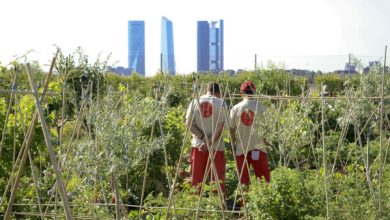Association of Crops in the Garden: The beneficial associations

As we have seen in the article on how to plan the garden, favorable crop associations can bring many benefits to our organic garden.
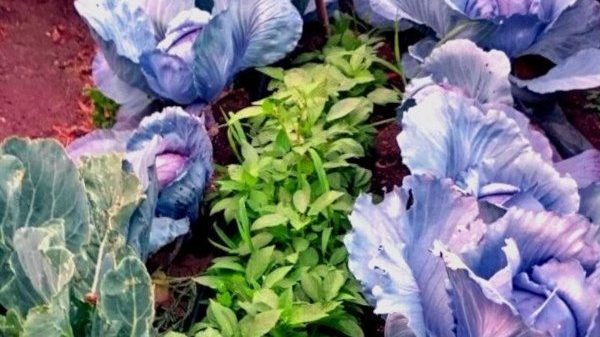
The needs of each type of crop are different and complement each other, so taking advantage of these differences by associating vegetables can help us minimize the competitive relationship between plants that grow together and the spread of pests and diseases.
What is intercropping and what benefits does it have?
The association of crops is a typical technique of traditional and ecological agriculture that consists of the simultaneous cultivation of compatible plants in the same place.
The association of crops in terraces (instead of planting each species separately) has many benefits for the development of the crop and the lower incidence of pests. In addition, the use by plants of light, water and nutrients is better than monoculture.

An example of association of vegetables is the cultivation of onions near carrots, since the former repel the carrot fly, a pest that causes significant damage to this crop. In addition, some associations also enhance flavor and growth.
There are other pairs of plants that are indifferent to each other and do neither harm nor benefit. There are also detrimental crop associations, incompatible plants whose combination can increase competition for resources and the incidence of pests.
Examples of intercropping in the garden
- Combine crops that have different growth speeds: if we plant a fast crop (lettuce for example) in the free space that exists until the slower crop (cabbage) grows, we take advantage of the space and there is hardly any competition between them.
- Plants from the same family are often incompatible in a companion crop, so we should avoid growing them together. Some examples: cucurbits (watermelon, melon, pumpkin, courgette, cucumber…), legumes (broad beans, beans, peas, lentils…) or nightshades (aubergine, tomato, pepper, potato…).
- Plant legumes to add nitrogen and other nutrients to the soil after some more voracious and demanding plant, which depletes the land, such as carrots, celery, corn, cucurbits or cruciferous vegetables (cabbage, cabbage, turnip…).
- Associate the cultivation of fruit and vegetables with floral and aromatic plants (such as mint or basil), which keep pests away or attract beneficial insects that favor biological control. Calendula, for example, attracts natural enemies of the green aphid and others such as sage, rosemary or thyme keep carrot and cabbage flies, ants and aphids away.
- The Pre- Columbian Association (corn + bean + pumpkin) is very interesting.
Crop Association Chart: Which Crops Can Be Grown Together and Which Cannot?
Below is a list that summarizes the compatibility of horticultural crops that I have prepared with the information from two very interesting books: «The urban garden. Organic cultivation manual on balconies and terraces» (Vallés, 2007) and «Sustainable urban garden» (Pérez and Velázquez, 2013).
If you want to know how to associate crops in a garden and decide, with knowledge of the facts, what to plant next to tomatoes or peppers, continue reading.

CHARD
- Beneficial association: Swiss chard, celery, onions, cabbage, beans, lettuce, peppers, radishes, tomatoes, carrots.
- Harmful association: Asparagus, leeks.
GARLIC
- Beneficial Association: Basil, aubergine, escarole, strawberries, lettuce, turnip, cucumber, pepper, beet, tomato, carrot.
- Harmful association: Cabbage, legumes (peas, broad beans, beans…), leek.
BASIL
- Beneficial association: Bean, cucumber, pepper, tomato.
ARTICHOKE
- Beneficial Association: Bean, lettuce, pea, radish.
- Harmful Association: Potato.
CELERY
- Beneficial Association: Chard, aubergine, spinach cabbage, bean, cucumber, leek, radish, pepper, tomato.
- Harmful association: Potato, carrot.
EGGPLANT
- Beneficial Association: Garlic, celery, borage, onion, cabbage, endive, spinach, beans, lettuce, potato, leek, radish, carrot.
- Harmful Association: Cucumber, zucchini.
BORAGE
- Beneficial Association: Aubergine, spinach, cucumber.
ZUCCHINI
- Beneficial Association: Basil, onion, peas, beans, lettuce, potato, corn.
- Harmful association: radish.
PUMPKIN

- Beneficial Association: Basil, onion, cabbage, peas, beans, lettuce and corn.
- Harmful association: radish, potato.
ONION
- Beneficial Association: Eggplant, courgette, cabbage, escarole, spinach, strawberry, lettuce, melon, cucumber, parsley, puerr, beetroot, watermelon, tomato, carrot.
- Harmful association: Pea, bean, potato.
CABBAGE
- Beneficial Association: Chard, celery, aubergine, pumpkin, onion, escarole, spinach, peas, beans, lettuce, turnip, potato, cucumber, pepper, leek, beet, tomato, carrot.
- Harmful Association: Garlic.
CAULIFLOWER
- Beneficial association: Celery, tomato.
- Harmful Association: Onion, cabbage, potato.
ENDIVE
- Beneficial Association: Garlic, aubergine, onion, cabbage, escarole, spinach, strawberries, turnip, leek.
ASPARAGUS
- Beneficial association: Pea, lettuce, cucumber, parsley, leek, radish, tomato.
- Harmful association: Onion, beet.
SPINACH
- Beneficial Association: Celery, aubergine, borage, onion, cabbage, escarole, strawberry, pea, broad bean, bean, lettuce, turnip, pepper, leek, radish, tomato and carrot.
- Harmful Association: Chard.
STRAWBERRY
- Beneficial Association: Garlic, onion, spinach, lettuce, leek, thyme.
- Harmful Association: Cabbage.
PEA
- Beneficial association: Celery, zucchini, cabbage, asparagus, spinach, lettuce, corn, melon, turnip, potato, cucumber, pepper, radish, watermelon, tomato, carrot.
- Harmful Association: Garlic, onion, bean, leek.
BEAN
- Beneficial Association: Artichoke, celery, spinach, lettuce, corn, potato, rosemary.
- Harmful Association: Garlic, cauliflower, leek.
BEAN
- Beneficial Association: Basil, chard, celery, aubergine, zucchini, pumpkin, cabbage, spinach, strawberry, lettuce, corn, turnip, potato, cucumber, pepper, radish, cabbage, tomato, carrot.
- Harmful association: garlic, onion, peas, broad bean, fennel, leek, beet.
LETTUCE
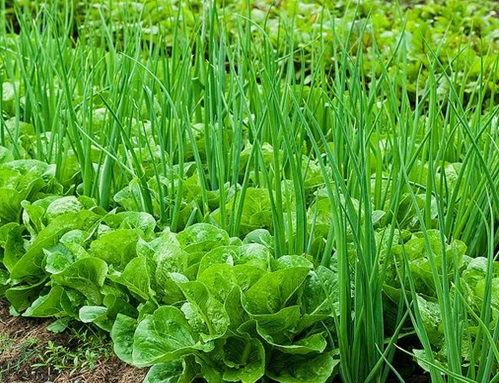
- Beneficial association: Garlic, aubergine, courgette, pumpkin, onion, cabbage, spinach, strawberry, peas, broad bean, bean, corn, melon, turnip, potato, cucumber, pepper, leek, radish, beet, watermelon, tomato, carrot.
- Harmful association: Celery, parsley.
CORN
- Beneficial association: Pumpkin, peas, broad beans, beans, melon, potato, cucumber, watermelon, tomato.
- Harmful association: Celery, beets.
CANTALOUPE
- Beneficial Association: Onion, peas, lettuce, corn.
TURNIP
- Beneficial association: cabbage, spinach, peas, beans, lettuce, cucumber, leek, beetroot, tomato.
- Harmful association: radish, carrot.
POTATO
- Beneficial Association: Eggplant, courgette, cabbage, broad bean, bean, corn, leek, radish, carrot.
- Harmful association: Celery, pumpkin, cucumber, pepper, tomato.
CUCUMBER
- Beneficial Association: Garlic, basil, celery, borage, onion, cabbage, asparagus, peas, beans, lettuce, corn, turnip, radish, beet.
- Harmful association: eggplant, potato, tomato.
PEPPER
- Beneficial association: Chard, garlic, basil, cabbage, spinach, peas, beans, lettuce, leek, radish.
- Harmful Association: Potato.
LEEK
- Beneficial Association: Celery, eggplant, onion, cabbage, escarole, spinach, lettuce, potato, pepper, beet, tomato, carrot.
- Harmful association: Garlic, peas, broad beans, beans, radishes.
RADISH
- Beneficial association: Chard, garlic, celery, aubergine, spinach, peas, beans, lettuce, potato, cucumber, pepper, tomato, carrot.
- Harmful association: Pumpkin, turnip, leek, cabbage.
BEETROOT
- Beneficial association: Celery, garlic, onion, cabbage, lettuce, turnip, cucumber, leek.
- Harmful association: Asparagus, bean, tomato, carrot.
CABBAGE
- Beneficial association: Celery, peas, beans, lettuce, potato, cucumber, leek, beet, tomato.
- Harmful Association: Garlic, onion, strawberry, fennel, radish.
WATERMELON
- Beneficial Association: Onion, peas, lettuce, corn.
TOMATOES
- Beneficial Association: Chard, garlic, basil, celery, onion, cabbage, asparagus, spinach, peas, beans, lettuce, corn, parsley, leek, radish, carrot.
- Harmful association: fennel, potato, cucumber, beet.
CARROT
- Beneficial Association: Chard, garlic, aubergine, onion, cabbage, peas, beans, lettuce, potato, leek, radish, tomato.
- Harmful association: Celery, beets.
I hope this information is useful to you More information about the association of vegetables in the post Associations of beneficial and harmful crops in the garden.
References
- Kolmans, E. & Vásquez, D., 1999. Organic Farming Manual. An introduction to basic principles and their application. Organic Agriculture Group. Cuban Association of Agricultural and Flower Technicians.
- Sauca Ibiricu, E. & Urabayen Aróstegui, D., 2005. Crop Rotations and Associations. Monographs Ekonekazaritza. Council of Agriculture and Organic Food of Euskadi (ENEEK). Biscay, Spain.
- Raigón, MD et al., 2006. Influence of crop association on soil equivalent ratio. Minutes of the VII SEAE Congress. Zaragoza (September 8-23), nº 159. Spanish Society of Organic Agriculture.
- Pérez López, G. & Velázquez Angulo, C., 2013. Sustainable Urban Garden. Ed. Mundi-Press.
- Torres Calderón, S. et al., 2018. Association of crops, maize and legumes for the conservation of soil fertility. Science, Technology and Development Magazine. vol. 4, nº1, p. 15-22


